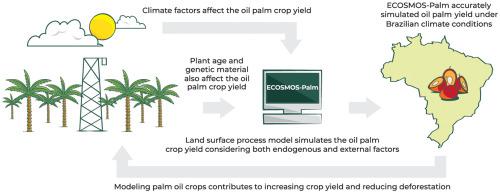Agricultural Systems ( IF 6.1 ) Pub Date : 2021-03-16 , DOI: 10.1016/j.agsy.2021.103130 Victor Hugo Benezoli , Hewlley Maria Acioli Imbuzeiro , Santiago Vianna Cuadra , Michel Anderson Almeida Colmanetti , Alessandro Carioca de Araújo , Christian Stiegler , Sérgio Yoshimitsu Motoike

|
CONTEXT
The increasing world demand for palm oil led to the expansion of oil palm plantations, especially in the new lands in Southeast Asia, the main producing region in the world. The expansion of oil palm plantations has also occurred in Latin American countries, such as Brazil. Roughly 400 million hectares in Brazil are suitable for the planting of oil palm, but most of this area is currently covered by forest, mainly by the Amazon Rainforest. Climate change has reduced the extent of land suitable for oil palm cultivation in Brazil since under unfavorable climatic conditions, crop yields are reduced. To reconcile the increase in oil palm production in Brazil with the preservation of forests, modeling has been used as a tool to define the best suitable areas for planting expansion, as well as for the assessment of management techniques that aim to increase the yield.
OBJECTIVE
Thus, the object of this study was to implement the oil palm crop sub-model in the ECOSMOS integrated simulator and to evaluate its performance to simulate oil palm energy and carbon balance and the crop yield.
METHODS
The carbon allocation scheme for oil palm is quite different from the other crops of ECOSMOS. So, we use the sub-PFT (plant functional type) approach, where each phytomer in the plant evolves simultaneously, but individually.
RESULTS AND Conclusions
The results showed that the model was able to simulate net radiation (Rn), latent heat flux (LE), and net ecosystem CO2 exchange (NEE) with good accuracy. In contrast, the sensible heat flux (H) was not well simulated due to the lack of information on the soil's physical-hydric properties. The model simulated accurately the annual yield for plants aged between 12 and 25 years, whereas the yield was overestimated for plants aged outside this range. Also, the model better simulated the yield of genetic varieties with seasonal yield, compared to varieties with more uniform yield over the months.
SIGNIFICANCE
The robust and consistent results presented for most of the evaluated processes, especially for energy and carbon fluxes, make the oil palm sub-model described here suitable for improve the oil palm production in Brazil. For future studies, efforts should be directed to consider key factors for oil palm, such as the ratio between male and female inflorescences and the abortion rate of inflorescences, which affect crop yield, for a better understanding of the oil palm growth and production.
中文翻译:

为巴西气候条件模拟油棕作物
语境
世界上对棕榈油的需求不断增长,导致油棕种植园的扩张,特别是在世界主要生产地区东南亚的新土地上。油棕种植园的扩张也发生在拉丁美洲国家,例如巴西。巴西大约有4亿公顷的土地适合种植油棕,但目前该地区的大部分地区都被森林覆盖,主要是亚马逊热带雨林。气候变化减少了巴西适合油棕种植的土地面积,因为在不利的气候条件下,农作物的产量降低了。为了调和巴西油棕产量的增长与森林的保护,建模已被用作一种工具,可以确定最适合种植面积的区域,
客观的
因此,本研究的目的是在ECOSMOS集成模拟器中实现油棕作物子模型,并评估其模拟油棕能量和碳平衡以及农作物产量的性能。
方法
油棕的碳分配方案与ECOSMOS的其他作物完全不同。因此,我们使用sub-PFT(植物功能类型)方法,其中植物中的每个phytomer同时但独立地进化。
结果与结论
结果表明,该模型能够较好地模拟净辐射(Rn),潜热通量(LE)和净生态系统CO 2交换(NEE)。相反,由于缺乏有关土壤物理水合特性的信息,因此无法很好地模拟显热通量(H)。该模型准确地模拟了12至25岁之间的植物的年产量,而超出该范围的植物的产量被高估了。此外,与几个月内单产均匀的品种相比,该模型更好地模拟了季节性单产的遗传品种的产量。
意义
对于大多数评估过程(尤其是对于能量和碳通量)所显示的可靠且一致的结果,使此处描述的油棕子模型适合于改善巴西的油棕产量。在以后的研究中,应该努力考虑油棕的关键因素,例如男女花序的比例和影响植物产量的花序流产率,以更好地了解油棕的生长和产量。











































 京公网安备 11010802027423号
京公网安备 11010802027423号